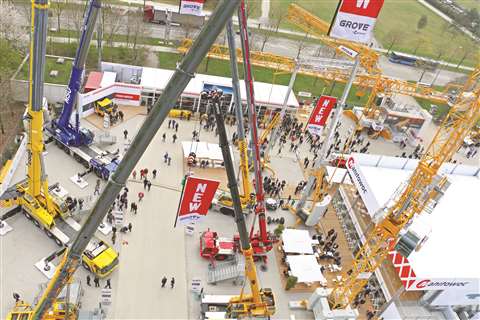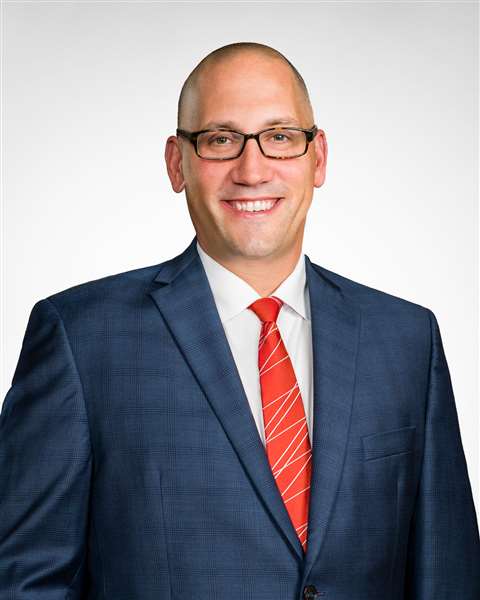Manitowoc’s Aaron Ravenscroft talks all things Bauma
10 October 2022
With two major tradeshows six months apart, OEMs made some tough choices. D.Ann Shiffler spoke with Aaron Ravenscroft about why Bauma offered the most ‘bang for the buck’ for Manitowoc.
At press time, the start of Bauma in Munich, Germany is a month out, and plans for the post-pandemic global trade show are at full-tilt. Machines are being readied for transport into the Messe München Trade Fair Center, and buildings are being erected right and left. Cranes are assisting in the set up of every type of construction equipment imaginable, and of course, there are cranes setting up cranes. The excitement is growing as there’s a lot of pent up demand for face-to-face meetings and to sell cranes and related equipment and services.
 Manitowoc CEO Aaron Ravenscroft is excited about Bauma and optimistic about new product roll outs and selling cranes. © Robert Dimmitt Photography
Manitowoc CEO Aaron Ravenscroft is excited about Bauma and optimistic about new product roll outs and selling cranes. © Robert Dimmitt Photography
Like all the construction equipment manufacturers participating in Bauma, Manitowoc President and CEO Aaron Ravenscroft is ready to go. The pandemic placed so many burdens on OEMs like Manitowoc, which weathered the Covid-19 storm admirably. But supply chain issues, rising prices and other challenges have been difficult to navigate. To say the least of the six-month delay of Bauma.
“The difficulty was the delay,” said Ravenscroft. “You plan for an event to be in April 2022 and then you have to delay it to October 2022. But we will have some big surprises like we normally do. You will see a whole compilation of new machines and machines we’ve recently released. I’m most excited because it’s the end of Covid.”
In anticipation of Bauma, I sat down with Ravenscroft for a Bauma-centric Q&A. He had a lot of positive things to say. He is optimistic, which is good news for the industry.
Based on the customers and distributors you are talking to, what sort of vibe do you expect in Germany?
I think it’s a mixed bag. I don’t expect as many Americans and people from the Asia Pacific region. When you think about the war in Ukraine, rising costs and even Covid, when I survey the dealers and customers we talk to a lot, I sense there will be fewer American attendees. The European market has also slowed down, [which may impact attendance].
But on the other hand, everyone is super excited to get out. It’s a big event and a lot to see. There is a lot of fellowship at these trade shows. I think there will be strong attendance from the Middle East, from Qatar, Kuwait and Saudi Arabia. There are a lot of projects going on in the Red Sea region. They need a lot of cranes.
We are all excited. The people we talk to who are going are excited.
A few American companies chose to skip Bauma and focus on ConExpo instead. Manitowoc took a different approach. Why is Bauma the better show for Manitowoc?
I think first and foremost, the timing was too difficult to do two shows in a world-class fashion. I genuinely feel like we will get more bang for the buck out of Bauma. There’s more social activity at ConExpo. At Bauma, there’s more intent on talking about cranes.
 Aaron Ravenscroft, President and CEO, Manitowoc Cranes
Aaron Ravenscroft, President and CEO, Manitowoc Cranes
But for us, it was driven by the timing. We’ve been super crazy focused on product development and this show. When it comes down to brass tacks, we have the Potain line in Europe and the tower crane line is so much more significant there.
Bauma is way more global, and ConExpo is very America-centric. We have committed to a Crane Days Customer Event in Shady Grove, Pennsylvania in lieu of ConExpo.
Trade shows are expensive, and then there is inflation. What about rising costs?
We’ve gotten push back on pricing. Everywhere you go there’s a discussion about inflation. Everyone has had to increase prices. So, it’s a combination of all of these. Given the challenge to execute and perform the way we want, as well as the prices and inflation, we’ve all had to hit the pause button on spending. That is why we are going down the Crane Days path, rather than ConExpo. We are trying to keep our prices as reasonable as we can.
Do you see a pent up demand for new products in the crane sector?
I’m not so sure. I think some of us were forced to launch machines early. In terms of Bauma, we would normally have more surprises had it been in April. Our competitors will have some interesting launches.
Can you tell us how many products you expect to launch at Bauma?
We will have two or three complete surprises. There are a fair number of cranes we’ve recently launched that we will show for the first time, like the Grove GMK5120L and the GMK5150XL. And the GMK6400-1. These cranes are new to the global stage.
As far as what we show, we will have 12 new cranes that have never been effectively seen: seven mobiles and five tower cranes. I know you are excited about them all, but which product lines/products are you most eager to discuss at Bauma?
I won’t talk about the surprises. But I will talk about the new Grove GMK6400-1. The original GMK6400 crane was first launched 2011. It was a groundbreaking machine. But it had a lot of quality problems, and the machine’s potential never played out.
I’m excited about relaunching this crane with our CCS system, new load charts and our MAXbase variable outrigger positioning system. It’s now a best-in-class crane. We hit the reset button on a crane that was an amazing machine on paper. We’ve taken our lessons and learned from them, and our early feedback is really positive. I think that’s super exciting for the GMK AT product line.
We will have one or two Grove rough terrain cranes. They will be equipped with Euromot 5 engines and meet current standards.
There’s also the Potain MR 229 luffing jib tower crane. It is significant as it’s the first luffing crane with CCS (crane control system) to improve performance and a platform for further luffing crane development.
I’m also excited about our Cranes+50 strategy – Manitowoc’s goal to grow non-new machine sales, i.e., aftermarket parts, services, rentals, used cranes and digital solutions by 50 percent by 2026, being led by our aftermarket support service. We launched Cranes+50 on the back of the two acquisitions last year and it’s going well, and we continue to accelerate it.
I am also excited about what we are doing with our tower crane rental fleet in Europe and the launch of our Grove Connect and Potain Connect digital platforms. It’s a positive evolution of CraneStar Diag, developed for Potain and Grove cranes. It features many advanced resources and way more capability for our customers.
Both Grove Connect and Potain Connect are our first foray into treating cranes like iPhones. We have more work to do, but what we are doing is exciting. The platform enables remote monitoring through an app-based system that allows owners and operators to view real-time crane information, receive alerts, exchange data and more. Further functionality will be added in the future.
Do you think a truly global crane exists, or should products be adapted to the specific markets in which they will be sold?
I don’t think there’s a global crane. There are similar numbers and designations in terms of models, but even in the U.S., cranes vary from state to state. We want to cover as many markets as possible. I’m not a big fan of the term global crane because every market is so different.
When you look at tower cranes, we have a complete engineering department for cranes in China. In Europe, most tower cranes are stand alone, and in Asia, after they reach a certain height, they are tied into the building. Wind specifications from country to country are different.
We always try to develop common booms that we can use in multiple applications on an AT or the pin boom on a rough terrain crane. We try to do what we can around standardization. But to say we are going to develop a global crane, no. When you enter that “one size fits all,” [thought process], we have not had success with that historically.
What about sustainability? Will you produce battery operated cranes?
This is a complicated topic. Class 8 trucks for example, there still isn’t enough electricity to power them. We have to develop something that will generate more electricity.
I think there is a lot of viability for a hybrid. But for us, we are going to be fast followers into this area rather than force our way into it. We are not the experts in this area. We are focused on being fast followers and trying to pick the winners.
What’s your favorite German meal?
I used to live in Munich, for almost two years. My favorite meal would be a Weiss Wurst and a beer. I’m looking forward to that. But I’ll need to go for a run or something first to earn it.
STAY CONNECTED


Receive the information you need when you need it through our world-leading magazines, newsletters and daily briefings.



